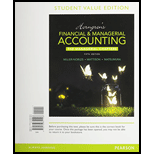
Concept explainers
Liabilities: Liabilities are debt and obligations of a business. These are the claims against the resources that a business owes to outsiders of the company. Liabilities may be Current liabilities, and Long-term liabilities. Examples: Creditors, Bills payable, Bank overdraft, Salaries and wages payable, and Notes payable.
To identify: The correct reporting place of estimated amounts of known liabilities.
Answer to Problem 1QC
Explanation of Solution
Explanation for correct answer: The estimated amounts of a transaction which is occurred in the past is called as known liabilities. Since they are liabilities, they must be reported on the balance sheet.
Explanation for incorrect answers:
- Option (a) is incorrect because known liabilities cannot be ignored, they should not be avoided.
- Option (c) is incorrect because on the income statement, only expenses and revenues should be reported, but not the liabilities.
- Option (d) is incorrect because notes to financial statements consist of additional data related to accounting methodologies of the income statement, balance sheet.
Want to see more full solutions like this?
Chapter 11 Solutions
Horngren's Financial & Managerial Accounting, The Managerial Chapters, Student Value Edition (5th Edition)
- What is the value of ending long term debt? Accounting questionarrow_forwardCompany B had an estimated 230,000 direct labor hours, $486,000 manufacturing overhead, and 27,000 machine hours. The actual were 220,700 direct labor hours, 38,600 machine hours, and $505,000 manufacturing overhead. They determine overhead based upon machine hours. Calculate the predetermined overhead rate.arrow_forwardWhat is the value of ending long term debt? Answer pleasearrow_forward
- Principles of Accounting Volume 1AccountingISBN:9781947172685Author:OpenStaxPublisher:OpenStax College
 Cornerstones of Financial AccountingAccountingISBN:9781337690881Author:Jay Rich, Jeff JonesPublisher:Cengage Learning
Cornerstones of Financial AccountingAccountingISBN:9781337690881Author:Jay Rich, Jeff JonesPublisher:Cengage Learning  College Accounting (Book Only): A Career ApproachAccountingISBN:9781337280570Author:Scott, Cathy J.Publisher:South-Western College Pub
College Accounting (Book Only): A Career ApproachAccountingISBN:9781337280570Author:Scott, Cathy J.Publisher:South-Western College Pub



